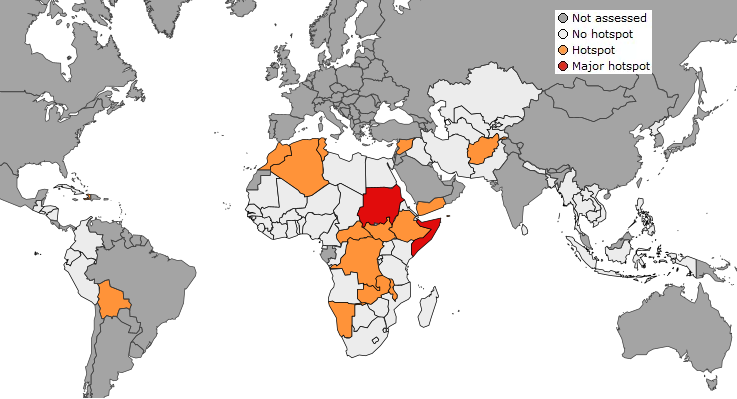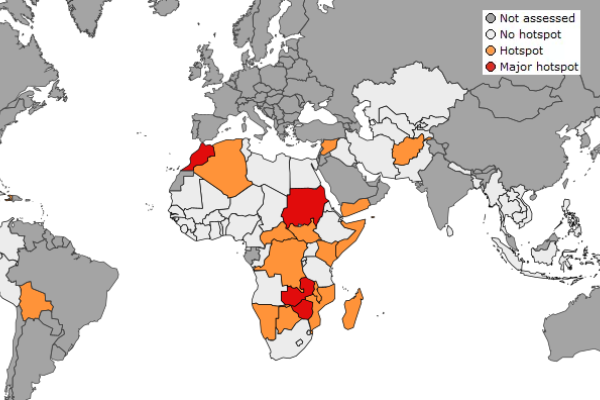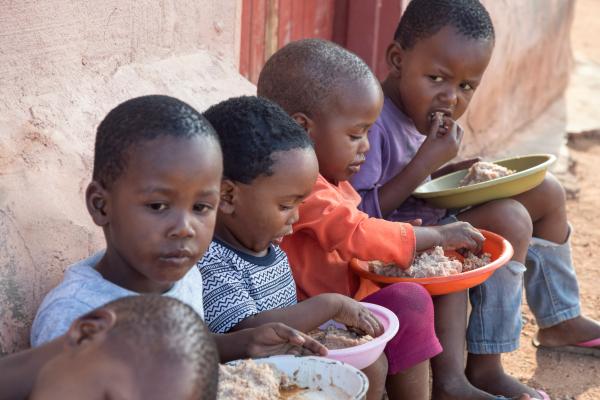
Main findings of the November global overview:
- In Southern Africa, rainfall is average during the early vegetative stages of summer cereal crops. A rainfall deficit is observed over crop and pastoral areas in southern Angola, northern Namibia, eastern Botswana, western Zimbabwe and eastern South Africa. The Copernicus rainfall forecast for December 2023-March 2024 points to drier-than-average conditions for most of the region, except for northern Angola, northwestern Zambia and northern Mozambique, where wetter-than-average conditions are forecast.
- In East Africa, severe floods linked to the ongoing El Niño event have affected the Somali region of Ethiopia, most of southern Somalia and many parts of Kenya. The main season harvest in the north the region experienced mixed production, whereas the main season crop production in Kenya’s unimodal areas is expected to be close to average. In Uganda, bi-seasonal crops have improved thanks to ongoing good rainfall. Levels of acute food insecurity remain high in the region, with nearly 28 million people in six IGAD countries (Kenya, Somalia, South Sudan, Djibouti, Uganda and Sudan) being in IPC Phase 3 or worse.
- In West and Central Africa, the main season is complete and cereal production is preliminarily forecast at 77.8 million tonnes, similar to the level of the previous year and 6% above the 5-year average (FAO (Crop Prospects, November 2023)). The second season maize in the Gulf of Guinea is progressing well.
- In North Africa, insufficient rainfall is negatively impacting planting activities and early season growth. The Copernicus rainfall forecast for December 2023-February 2024 points towards below-average rainfall. On the contrary, in the Middle East, above-average temperatures and good rainfall have been favourable to the sowing and early growth of winter wheat. Only in the north and northeast of Iran has rainfall been below average. In Yemen, the harvest prospects are favourable for sorghum and maize in the highlands, and sorghum and millet in western coastal areas.
- In Central Asia, the sowing of winter wheat ended under above-average temperatures and below-average rainfall in the past month. In Afghanistan, the sowing of (irrigated) winter wheat is underway under decreased rainfall conditions across the main cereal-producing area of the north. In South Asia, prospects for summer (Kharif) crops in Pakistan are average, and prospects for wet season (Aman) rice in Bangladesh are above average. In Sri Lanka, the biomass of rice and maize crops in the early vegetative stage is above average.
- In continental South-East Asia, the harvest of main season rice is underway with average to above-average prospects, while the planting of dry season rice has started in some regions of central Thailand, Cambodia and southern Vietnam. In Indonesia, the harvest of dry season rice ended with close-to-average prospects, while the planting of main season rice and maize is delayed by the late start of the rainy season as a result of a strong El Niño. In North Korea, the sowing of winter wheat and barley was completed under mild temperatures and average rainfall conditions.
- In Latin America and the Caribbean islands, the Postrera cycles have benefitted from average to above-average rainfall received in the past month, and vegetation conditions are average to above average. The sowing of rice in Bolivia is likely facing difficulties due to the poor rainfall conditions affecting key grain-producing departments, including Santa Cruz. Above-average rainfall is forecast by the Copernicus C3S multi-model for the region until the end of January 2024, apart from Bolivia where the forecast points to drier-than-average conditions throughout the country.
The next assessment is scheduled for the end of January 2024.
Details
- Publication date
- 8 December 2023
- Author
- Joint Research Centre
- JRC portfolios




